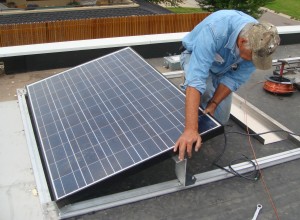 So…I did not want to write about our solution to the last “solar blip” post until it was actually happening. (I have gotten rather jaded and won’t believe things until I see them.) But yesterday, 16 Centrosolar photovoltaic panels were delivered to our roof! I can hear them now walking on top of my office (above the garage), working on installing them.
So…I did not want to write about our solution to the last “solar blip” post until it was actually happening. (I have gotten rather jaded and won’t believe things until I see them.) But yesterday, 16 Centrosolar photovoltaic panels were delivered to our roof! I can hear them now walking on top of my office (above the garage), working on installing them.
I should back up….what happened to teKsolar, the Minnesota-based start up? They are not yet ready for residential due to a radio frequency rating, and they will not be ready for at least another year. We had already been approved for the Minnesota State rebate, and the Xcel rebate was in the works. The first decision was: do we go ahead with a different system (with an installation deadline of September 30th for the rebate), or do we just wait for tenKsolar? I was inclined to continue the march. To me, if you believe in solar, you need to get it as soon as possible so it can start working for you as soon as possible. As our state government is running out of money, I figured we ought to get it while we can.
The biggest competition to tenKsolar is a conventional photovoltaic system using Enphase Micro-inverters. One of the reasons tenKsolar went into business was to solve this weakest link problem: in traditional systems, the performance of the entire system is dictated by the performance of the weakest module. So, for example, if one panel is in the shade and is performing at only 25%, all modules will perform at 25%, greatly reducing power output. TenKsolar addresses this issue (in the design of the panel collectors themselves), as well as Enphase Micro-inverters (in the electrical wiring design). So, that’s the system we are getting. The downside of not going with tenKsolar is that I really like their racking system — it is integrated into the whole panel system and is designed for flat roofs. The upside of going with the Enphase system is two-fold:
1. The products have already been proven in the marketplace, lowering our risk, and
2. The Enphase Microinverters come with a fancy software package so I can monitor our solar panels online (and even on my phone)! Yes, I am a bit geeky.
From a pricing standpoint, the systems were pretty close to the same, and we stuck with our original electrical contractor because they seemed more conscientious than the others. I won’t talk about payback or return on our investment until all of our rebates and tax credits actually come in, but let’s just say the lengthy negotiations and a surprise neighborhood solar energy grant will make this a screaming good deal for us.
Now the issue. There always is one, at least. Someone, somewhere, did not measure our roof correctly, and we can only fit 12 of the 16 panels on the roof. We need to find space for the other 4, or else go down in size by 25%, about which I am not thrilled. We are looking at potentially using the remaining 4 as awnings for windows on the south side of our house, placed at a 45 degree angle. I think this would be great, but my opinion is not the only one that matters in this household. We need to decide pretty soon; I have called in help from our architect. Our electrical contractor has assured me that this has NEVER happened to him before. (The number of times I have heard that phrase — I’ve never seen that happen! — from various subcontractors is mind jiggling.) Glad to be the guinea pigs. Grunt.
